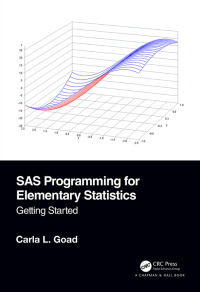Buy SAS Programming for Elementary Statistics: Getting Started 1st Edition PDF ebook by author Carla L. Goad – published by Chapman & Hall in 2021 and save up to 80% compared to the print version of this textbook. With PDF version of this textbook, not only save you money, you can also highlight, add text, underline add post-it notes, bookmarks to pages, instantly search for the major terms or chapter titles, etc.
You can search our site for other versions of the SAS Programming for Elementary Statistics: Getting Started 1st Edition PDF ebook. You can also search for others PDF ebooks from publisher Chapman & Hall, as well as from your favorite authors. We have thousands of online textbooks and course materials (mostly in PDF) that you can download immediately after purchase.
Note: e-textBooks do not come with access codes, CDs/DVDs, workbooks, and other supplemental items.
eBook Details:
Full title: SAS Programming for Elementary Statistics: Getting Started 1st Edition
Edition: 1st
Copyright year: 2021
Publisher: Chapman & Hall
Author: Carla L. Goad
ISBN: 9781138589094, 9780429959295
Format: PDF
Description of SAS Programming for Elementary Statistics: Getting Started 1st Edition:
SAS for Elementary Statistics: Getting Started provides an introduction to SAS programming for those who have experience with introductory statistical methods. It is also an excellent programming supplement for an introductory statistics course. It is appropriate for the beginning programmer with no prior SAS experience and the researcher who would like to refresh SAS programming skills. These lessons are those the author has found successful in the classroom. Strengths of this book include the following: Examples are easy to follow and understand. Chapters have user-friendly text and objectives. Each chapter has clear objectives with SAS syntax and output results given. Objectives are stated as tasks with detailed step-by-step instructions. Programming notes based on the author’s experience occur throughout the book. The author assists the reader in making sense of the error messages in the SAS log. Brief reviews of statistical methods are included in chapters accompanying the corresponding SAS procedures. Easy transition from user terminology to SAS terminology is provided. The ability to select or suppress results using Output Delivery System (ODS) is made simple. Reading and writing to external files are among the most used SAS skills, and these concepts are clearly presented. The IMPORT and EXPORT procedures and ODS are used to accomplish these tasks. Statistical Graphics procedures and SAS/GRAPH can be quite challenging to learn, but these are presented in a very achievable format. Basic graph construction is first introduced then readers learn how to add color, pattern, and other enhancements to graphics images.





